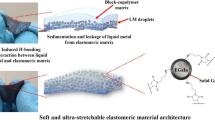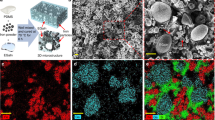Abstract
Gallium-based liquid metal/elastomer matrix composites (LMECs) have attracted increasing attention in stretchable electronics, soft robots and sensors due to their combination of high electrical conductivity and liquid fluidity. Their electrical performance is significantly dependent on droplet size, morphology and the Ga2O3 layer surrounding the LM droplets. Numerical results demonstrated that imposing only a mild pressure of 0.25 MPa could lead to the rupture of LM droplets during mechanical sintering. The electromechanical stability in body-centered cubic (BCC) architecture was higher than that in face-centered cubic (FCC) architecture. Additionally, the orientation of chained LM droplets against the stretching direction greatly affects the resistance variation, and the simulated network morphology can better replicate the experimental results.




Similar content being viewed by others
Data Availability
The data that support the findings of this study are available from YPJ upon reasonable request.
References
E.J. Markvicka, M.D. Bartlett, X. Huang, C. Majidi, An autonomously electrically self-healing liquid metal–elastomer composite for robust soft-matter robotics and electronics. Nat. Mater. 17, 618 (2018).
R. Tutika, S. Kmiec, A.B.M. Tahidul Haque, S.W. Martin, and M.D. Bartlett, Liquid metal–elastomer soft composites with independently controllable and highly tunable droplet size and volume loading. ACS Appl. Mater. Interfaces 11, 17873 (2019).
A. Fassler and C. Majidi, Liquid-phase metal inclusions for a conductive polymer composite. Adv. Mater. 27, 1928 (2015).
Y.L. Lin, C. Cooper, M. Wang, J.J. Adams, J. Genzer, and M.D. Dickey, Handwritten, soft circuit boards and antennas using liquid metal nanoparticles. Small 48, 6397 (2015).
M.G. Saborio, S.X. Cai, J.B. Tang, M.B. Ghasemian, M. Mayyas, J.L. Han, M.J. Christoe, S.H. Peng, P. Koshy, D. Esrafilzadeh, R. Jalili, C.H. Wang, and K. Kalantar-Zadeh, Liquid metal droplet and graphene co-fillers for electrically conductive flexible composites. Small 16, 1903753 (2020).
J.Y. Yang, D. Tang, J.P. Ao, T. Ghosh, T.V. Neumann, D.G. Zhang, E. Piskarev, T.T. Yu, V.K. Truong, K. Xie, Y.C. Lai, Y. Li, and M.D. Dickey, Ultrasoft liquid metal elastomer foams with positive and negative piezopermittivity for tactile sensing. Adv. Funct. Mater. 30, 2002611 (2020).
A. Ozcariz, D.A. Piña-Azamar, C.R. Zamarreño, R. Dominguez, and F.J. Arregui, Aluminum doped zinc oxide (AZO) coated optical fiber LMR refractometers—an experimental demonstration. Sens. Actuators B Chem. 281, 698 (2019).
J. Zhang, M. Liu, G. Pearce, Y.Y. Yu, Z. Sha, Y. Zhou, A.C.Y. Yuen, C.Y. Tao, C. Boyer, F. Huang, M. Islam, and C.H. Wang, Strain stiffening and positive piezoconductive effect of liquid metal/elastomer soft composites. Compos. Sci. Technol. 201, 108497 (2021).
Q.T. Zhang, G.L. Yun, B.L. Zhao, H.D. Lu, S.W. Zhang, S.Y. Tang, and W.H. Li, Highly stretchable and sensitive strain sensor based on liquid metal composite for wearable sign language communication device. Smart Mater. Struct. 30, 115005 (2021).
Z. Wang, X. Xia, M. Zhu X. Zhang, R. Liu, J. Ren, J. Yang, M. Li, J. Jiang, Y. Liu, Rational assembly of liquid metal/elastomer lattice conductors for high-performance and strain-invariant stretchable electronics. Adv. Funct. Mater. 32, 2108336 (2022).
N. Cohen and K. Bhattacharya, A numerical study of the electromechanical response of liquid metal embedded elastomers. Int. J. Nonlinear. Mech. 108, 81 (2019).
Y.Y. Zhao, P. Khandagale, and C. Majidi, Modeling electromechanical coupling of liquid metal embedded elastomers while accounting stochasticity in 3D percolation. Extreme Mech. Lett 48, 101443 (2021).
N. Zolfaghari, P. Khandagale, M.J. Ford K. Dayal, C. Majidi, Network topologies dictate electromechanical coupling in liquid metal–elastomer composites. Soft Matter 16, 8818 (2020).
Y.P. Jiang, Y. Zhu, and T.Y. Li, Computational micromechanics of the elastic behaviors of liquid metal–elastomer composites. MRS Commun. 12, 465 (2022).
N.J. Morris, Z.J. Farrell, and C.E. Tabor, Chemically modifying the mechanical properties of core–shell liquid metal nanoparticles. Nanoscale 11, 17308 (2019).
C. Pan, E.J. Markvicka, M.H. Malakooti J. Yan, L. Hu, K. Matyjaszewski, C. Majidi, A liquid-metal–elastomer nanocomposite for stretchable dielectric materials. Adv. Mater. 31, 1900663 (2019).
H.W. Bark and P.S. Lee, Surface modification of liquid metal as an effective approach for deformable electronics and energy devices. Chem. Sci. 12, 2760 (2021).
M.D. Dickey, R.C. Chiechi, R.J. Larsen, E.A. Weiss, D.A. Weitz, and G.M. Whitesides, Eutectic gallium-indium (EGaIn): a liquid metal alloy for the formation of stable structures in microchannels at room temperature. Adv. Funct. Mater. 18, 1097 (2008).
M.D. Dickey, EML webinar overview: Liquid metals at the extreme. Extreme. Mech. Lett. 40, 100863 (2020).
A.R. Jacob, D.P. Parekh, M.D. Dickey, and L.C. Hsiao, Interfacial rheology of gallium-based liquid metals. Langmuir 35, 11774 (2019).
R.J. Larsen, M.D. Dickey, G.M. Whitesides, and D.A. Weitz, Viscoelastic properties of oxide-coated liquid metals. J. Rheol. 53, 1305 (2009).
ABAQUS, Version 6.11 Documentation, Dassault Systemes Simulia Corp. (2011).
M.H. Malakooti, M.R. Bockstaller, K. Matyjaszewski, and C. Majidi, Liquid metal nanocomposites. Nanoscale Adv. 2, 2668 (2020).
N.J. Morris, Z.J. Farrell, and C.E. Tabor, Chemically modifying the mechanical properties of core-shell liquid metal nanoparticles. Nanoscale 11, 17308 (2019).
C. Chiew and M.H. Malakooti, A double inclusion model for liquid metal polymer composites. Compos. Sci. Technol. 208, 108752 (2021).
M.J. Ford, D.K. Patel, C. Pan, S. Bergbreiter, and C. Majidi, Controlled assembly of liquid metal inclusions as a general approach for multifunctional composites. Adv. Mater. 32(46), 2002929 (2020).
M.D. Bartlett, A. Fassler, N. Kazem, E.J. Markvicka, P. Mandal, and C. Majidi, Stretchable, high-k dielectric elastomers through liquid-metal inclusions. Adv. Mater. 28, 3726 (2016).
S.Q. Liang, Y.Y. Li, Y.Z. Chen, J.B. Yang, T.P. Zhu, D.Y. Zhu, C.X. He, Y.Z. Liu, S. Handschuh-Wang, and X.C. Zhou, Liquid metal sponges for mechanically durable, all-soft, electrical conductors. J. Mater. Chem. C 5, 1586 (2017).
Acknowledgments
This work was financially supported by the Fundamental Research Funds for the Central Universities (NS2022012)
Author information
Authors and Affiliations
Corresponding author
Ethics declarations
Conflict of interest
On behalf of all authors, the corresponding author states that there is no conflict of interest.
Additional information
Publisher's Note
Springer Nature remains neutral with regard to jurisdictional claims in published maps and institutional affiliations.
Appendix
Appendix
Modeling of critical pressure in mechanical sintering
See Figs. 5
,
The critical pressure to be determined by the divergence between the pressure-stretch ratio curves and the associated rupture contour of LM droplets. Here, the pressure-stretch ratio curve with damage criterion deviates from that with no damage effect at a critical point, whereby the corresponding pressure at this point was assigned as the minimum pressure to break LM droplets.
6,
7 and
Rights and permissions
Springer Nature or its licensor (e.g. a society or other partner) holds exclusive rights to this article under a publishing agreement with the author(s) or other rightsholder(s); author self-archiving of the accepted manuscript version of this article is solely governed by the terms of such publishing agreement and applicable law.
About this article
Cite this article
Jiang, Y., Zhu, Y. Numerical Investigation on the Piezo-Resistive Effect of Ga-Based Liquid Metal Filled Elastomers. J. Electron. Mater. 53, 499–507 (2024). https://doi.org/10.1007/s11664-023-10792-1
Received:
Accepted:
Published:
Issue Date:
DOI: https://doi.org/10.1007/s11664-023-10792-1








